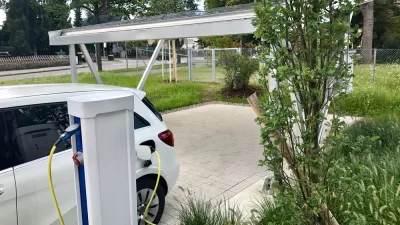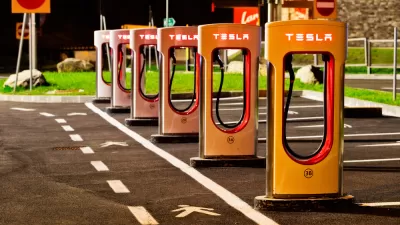The new IPCC report calls for decarbonization of transportation. While many cities are attempting to do their part, two recent federal developments in trade policy and tax legislation threaten to will make progress more difficult.

"Plugging in cars and trucks will be critical to averting climate catastrophe," writes Rebecca Bellan for CityLab about the "Special Report on Global Warming of 1.5°C," released Oct. 8 by the United Nations’ Intergovernmental Panel on Climate Change (IPCC), warning of dire consequences from climate change as early as 2040.
In the U.S., the world’s second-largest producer of greenhouse gases, transportation makes up the largest share of emissions.
In cities, passenger vehicles and public transit fleets will have to move from fuel-burning engines to electrification, a “powerful measure to decarbonize short-distance vehicles,” according to the IPCC report.
[See related Planetizen post: "Averting Climate Catastrophe Means Rethinking Our Transportation Habits", also from CityLab].
Bellan describes many examples of successful efforts throughout the U.S. where progress, even if on a small level, is noteworthy. Among them:
- "Last year, Atlanta passed a landmark ordinance that requires all new residential homes and public parking facilities to accommodate EVs and 20 percent of the spaces in all new commercial and multi-family parking structures to be plug-in ready."
- Two all-electric car-share companies, GIG Car Share and Envoy Technologies, are working to launch their services in Sacramento funded by a unique Electrify America grant, report Tony Bizjak and Ryan Lillis for The Sacramento Bee.
- On Sept. 11, Los Angeles Mayor Eric Garcetti launched the Climate Mayors EV Purchasing Collaborative, an online platform and resource portal that guides and encourages city leaders to obtain EVs for municipal fleets. As a result of the new platform, 20 founding Climate Mayors' cities and two counties have committed to purchasing 391 EVs — a figure that is expected to grow as the program continues to engage cities across the country.
And in one Silicon Valley city, electric vehicles comprised 30% of sales last year, according to an Oct. 16 post from Ethan Elkind: "Palo Alto: Electric Vehicle “Capital Of America.”
However, in the nation's capital, two notable developments would hamper the efforts to switch from fossil fuels to electricity to power vehicles.
NAFTA replacement not good for electric vehicles
The new United States-Mexico-Canada-Agreement, which could be signed in San Antonio by President Trump, Canadian Prime Minister Justin Trudeau, and Mexican President Enrique Peña Nieto if three congress members from San Antonio have their way, "calls for 75 percent of the content of a car or truck to be made from parts made in North America," explains Bellan.
Right now, the average conventional vehicle manufactured in the U.S. uses about 50 to 60 percent U.S.-Canadian content, but many electric vehicles are down in the 20 to 30 percent content range [pdf]. Tariffs on that imported content will cause the average vehicle price to go up further, which may put downward pressure on adoption. Combined with the additional steel and aluminum tariffs, the new USMCA may mean widespread EV adoption is a pipe dream for the immediate future.
Potential loss of electric vehicle credit
Last year, the House Tax Cuts and Jobs Act would have eliminated the Federal Plug-In Electric Drive Vehicle Credit, worth up to $7,500 for buyers or lessees of battery-electric vehicles. The Senate ultimately deleted that provision.
On Oct. 6, Sen. John Barrasso (R-Wyo) introduced S.3559 - Fairness for Every Driver Act, which eliminates the credit, worth up to $7,500. Furthermore, it adds a new Federal highway user fee on alternative fuel vehicles, deposited to the Highway Trust Fund.
“The electric vehicle tax credit largely benefits the wealthiest Americans and costs taxpayers billions of dollars,” said Barrasso in a statement released by the Senate Committee on Environment and Public Works, which he chairs.
“My legislation levels the playing field for all drivers across America. Gas, electric, and alternative fuel vehicles use the same roads. All should contribute to maintain them. My bill supports the Highway Trust Fund by making sure all drivers pay into the account that improves America’s roads.”
"'Oil and gas' is one of the top sectors to donate to Barrasso’s campaign, according to OpenSecrets," observes Fred Lambert in a critical piece in Electrek on the legislation. "Chevron and Murray Energy are amongst Barrasso’s top donors."
Even without the legislation, Lambert notes that "[l]ast quarter, Tesla became the first automaker to hit the 200,000 delivery threshold to initiate a phase-out period of the credit over the next year."
To increase EV adoption, it's clear that incentives and perks are necessary, as illustrated by Norway's success. Electric vehicles accounted for 39 percent of Norway’s new car sales in 2017, and 6.4 percent of the country’s cars are powered by electricity, according to Tom DiChristopher of CNBC (posted here).
By contrast, Brennan of CityLab sadly observes that only 1.15 percent of all cars sold in 2017 were plug-ins. "But, to put that in perspective, that’s a 26 percent increase from 2016, and the trend is expected to continue, according to environmental advocates and EV industry experts."
In California, where Gov. Jerry Brown set a goal of getting five million zero-emission vehicles on the roads by 2030, the adoption rate is considerably higher, over 6 percent for the first half of the year, as posted Aug. 24: "SUVs Sales Increase in California While Car Sales Drop—Except Those with Plugs."
FULL STORY: Can We Go Electric Before It’s Too Late?

Study: Maui’s Plan to Convert Vacation Rentals to Long-Term Housing Could Cause Nearly $1 Billion Economic Loss
The plan would reduce visitor accommodation by 25,% resulting in 1,900 jobs lost.

North Texas Transit Leaders Tout Benefits of TOD for Growing Region
At a summit focused on transit-oriented development, policymakers discussed how North Texas’ expanded light rail system can serve as a tool for economic growth.

Why Should We Subsidize Public Transportation?
Many public transit agencies face financial stress due to rising costs, declining fare revenue, and declining subsidies. Transit advocates must provide a strong business case for increasing public transit funding.

How to Make US Trains Faster
Changes to boarding platforms and a switch to electric trains could improve U.S. passenger rail service without the added cost of high-speed rail.

Columbia’s Revitalized ‘Loop’ Is a Hub for Local Entrepreneurs
A focus on small businesses is helping a commercial corridor in Columbia, Missouri thrive.

Invasive Insect Threatens Minnesota’s Ash Forests
The Emerald Ash Borer is a rapidly spreading invasive pest threatening Minnesota’s ash trees, and homeowners are encouraged to plant diverse replacement species, avoid moving ash firewood, and monitor for signs of infestation.
Urban Design for Planners 1: Software Tools
This six-course series explores essential urban design concepts using open source software and equips planners with the tools they need to participate fully in the urban design process.
Planning for Universal Design
Learn the tools for implementing Universal Design in planning regulations.
City of Santa Clarita
Ascent Environmental
Institute for Housing and Urban Development Studies (IHS)
City of Grandview
Harvard GSD Executive Education
Toledo-Lucas County Plan Commissions
Salt Lake City
NYU Wagner Graduate School of Public Service



























